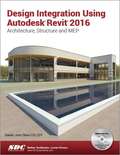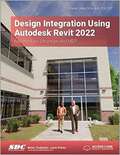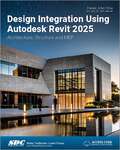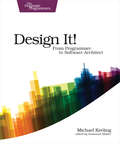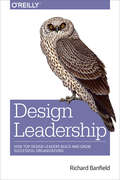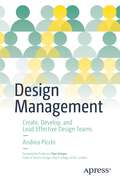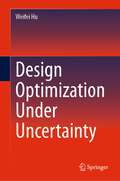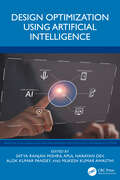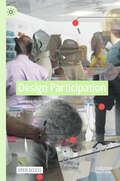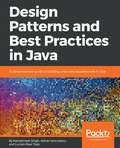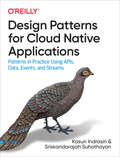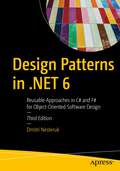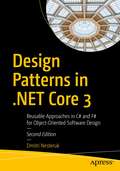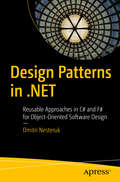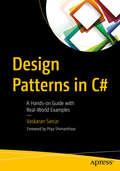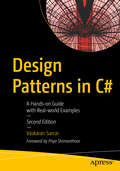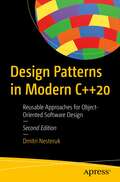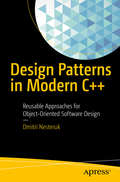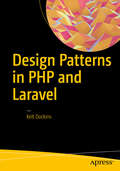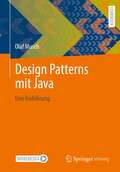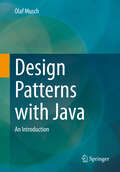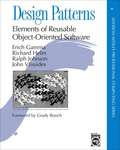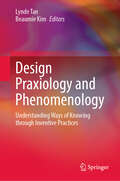- Table View
- List View
Design Integration Using Autodesk Revit 2016
by Daniel John StineDesign Integration Using Autodesk Revit 2016
Design Integration Using Autodesk Revit 2022
by Daniel John StineDesign Integration Using Autodesk Revit 2022 is designed to provide you with a well-rounded knowledge of Autodesk Revit tools and techniques. <p><p>All three disciplines of the Revit platform are introduced in this textbook. This approach gives you a broad overview of the Building Information Modeling (BIM) process. The topics cover the design integration of most of the building disciplines: Architectural, Interior Design, Structural, Mechanical, Plumbing and Electrical. Civil is not covered, but adding topography to your model is. Each book also includes access to nearly 100 video tutorials designed to further help you master Autodesk Revit. <p><p> Throughout the book you develop a two story law office. The drawings start with the floor plans and develop all the way to photo-realistic renderings similar to the one on the cover of this book. Along the way the building’s structure, ductwork, plumbing and electrical (power and lighting) are modeled. By the end, you will have a thorough knowledge of many of the Revit basics needed to be productive in a classroom or office environment. Even if you will only be working with one component of Revit in your chosen profession, this book will give you important knowledge on how the other disciplines will be doing their work and valuable insight into the overall process. <p><p> The first four chapters cover many of the Revit basics needed to successfully and efficiently work with the software. Once the fundamentals are covered, the remaining chapters walk you through a building project which is started from scratch so nothing is taken for granted by you or the author.
Design Integration Using Autodesk Revit 2025: Architecture, Structure and MEP
by Daniel John StineDesign Integration Using Autodesk Revit 2025 is designed to provide you with a well-rounded knowledge of Autodesk Revit tools and techniques. All three disciplines of the Revit platform are introduced in this textbook. This approach gives you a broad overview of the Building Information Modeling (BIM) process. The topics cover the design integration of most of the building disciplines: Architectural, Interior Design, Structural, Mechanical, Plumbing and Electrical. Civil is not covered, but adding topography to your model is. Each book also includes access to video tutorials designed to further help you master Autodesk Revit. Throughout the book you develop a two story law office. The drawings start with the floor plans and develop all the way to photo-realistic renderings similar to the one on the cover of this book. Along the way the building’s structure, ductwork, plumbing and electrical (power and lighting) are modeled. By the end, you will have a thorough knowledge of many of the Revit basics needed to be productive in a classroom or office environment. Even if you will only be working with one component of Revit in your chosen profession, this book will give you important knowledge on how the other disciplines will be doing their work and valuable insight into the overall process. The first four chapters cover many of the Revit basics needed to successfully and efficiently work with the software. Once the fundamentals are covered, the remaining chapters walk you through a building project which is started from scratch so nothing is taken for granted by you or the author.
Design Is The Problem
by Nathan ShedroffDesign makes a tremendous impact on the produced world in terms of usability, resources, understanding, and priorities. What we produce, how we serve customers and other stakeholders, and even how we understand how the world works is all affected by the design of models and solutions. Designers have an unprecedented opportunity to use their skills to make meaningful, sustainable change in the world--if they know how to focus their skills, time, and agendas. In Design is the Problem: The Future of Design Must be Sustainable, Nathan Shedroff examines how the endemic culture of design often creates unsustainable solutions, and shows how designers can bake sustainability into their design processes in order to produce more sustainable solutions.
Design It!: From Programmer to Software Architect
by Michael KeelingDon't engineer by coincidence-design it like you mean it! Filled with practical techniques, Design It! is the perfect introduction to software architecture for programmers who are ready to grow their design skills. Lead your team as a software architect, ask the right stakeholders the right questions, explore design options, and help your team implement a system that promotes the right -ilities. Share your design decisions, facilitate collaborative design workshops that are fast, effective, and fun-and develop more awesome software!With dozens of design methods, examples, and practical know-how, Design It! shows you how to become a software architect. Walk through the core concepts every architect must know, discover how to apply them, and learn a variety of skills that will make you a better programmer, leader, and designer. Uncover the big ideas behind software architecture and gain confidence working on projects big and small. Plan, design, implement, and evaluate software architectures and collaborate with your team, stakeholders, and other architects. Identify the right stakeholders and understand their needs, dig for architecturally significant requirements, write amazing quality attribute scenarios, and make confident decisions. Choose technologies based on their architectural impact, facilitate architecture-centric design workshops, and evaluate architectures using lightweight, effective methods. Write lean architecture descriptions people love to read. Run an architecture design studio, implement the architecture you've designed, and grow your team's architectural knowledge. Good design requires good communication. Talk about your software architecture with stakeholders using whiteboards, documents, and code, and apply architecture-focused design methods in your day-to-day practice. Hands-on exercises, real-world scenarios, and practical team-based decision-making tools will get everyone on board and give you the experience you need to become a confident software architect.
Design Leadership: How Top Design Leaders Build and Grow Successful Organizations
by Richard BanfieldWhat does it take to be the leader of a design firm or group? We often assume they have all the answers, but in this rapidly evolving industry they’re forced to find their way like the rest of us. So how do good design leaders manage? If you lead a design group, or want to understand the people who do, this insightful book explores behind-the-scenes strategies and tactics from leaders of top design companies throughout North America.Based on scores of interviews he conducted over a two-year period—from small companies to massive corporations like ESPN—author Richard Banfield covers a wide range of topics, including:How design leaders create a healthy company cultureInnovative ways for attracting and nurturing talentCreating productive workspaces, and handling remote employeesStaying on top of demands while making time for themselvesConsistent patterns among vastly different leadership stylesTechniques and approaches for keeping the work pipeline fullMaking strategic and tactical plans for the futureMistakes that design leaders made—and how they bounced back
Design Made Easy with Inkscape: A practical guide to your journey from beginner to pro-level vector illustration
by Christopher RogersDiscover quick and easy ways to make charts, diagrams, illustrations, and UX/UI mockups with end-to-end guidance using hands-on tutorials, tips, and tricksKey FeaturesGet up to speed with vector illustration in no timeExplore hotkey charts and tips, with best practices developed over ten years of using InkscapeLearn the fundamentals of vector illustration and efficiently leverage Inkscape's powerful toolsetBook DescriptionWith the power and versatility of the Inkscape software, making charts, diagrams, illustrations, and UI mockups with infinite resolution becomes enjoyable. If you're looking to get up to speed with vector illustration in no time, this comprehensive guide has got your back! Design Made Easy with Inkscape is easy to follow and teaches you everything you need to know to create graphics that you can use and reuse forever, for free! You'll benefit from the author's industry experience as you go over the basics of vector illustration, discovering tips and tricks for getting professional graphics done fast by leveraging Inkscape's powerful toolset. This book teaches by example, using a great variety of use cases from icons and logos to illustration, web design, and product design. You'll learn about hotkeys and take a best-practices approach developed over ten years of using Inkscape as a design tool in production. What's more, this book also includes links to free graphics resources that you can use in all your projects. Whether you're a new user or a professional, by the end of this book, you'll have full understanding of how to use Inkscape and its myriad of excellent features to make stunning graphics for your projects.What you will learnUnderstand the benefits of vector illustration and the reasons behind choosing Inkscape over other non-free alternativesNavigate the Inkscape setup and workspace to make effective use of the softwareExplore the wide range of tools from Inkscape to create amazing and infinitely scalable graphics quicklyUse real-world scenarios and practice lessons to learn how to create by exampleDiscover tips and tricks to make Inkscape an extension of your creativityConvert photos to vector art and practice with professional design examples as you work with layers, shading, coloring and much moreWho this book is forThis book is for aspiring designers, developers, and anyone who wants to leverage the power of Inkscape for vector illustration. No prior knowledge of graphics applications or vector and raster graphics is required. This book simplifies Inkscape for dummies; all you need to know is how to use a mouse and keyboard.
Design Management: Create, Develop, and Lead Effective Design Teams
by Andrea PicchiDesigners are more in-demand than ever, and companies all over the world are creating new leadership roles to manage them. With only a few select institutions teaching effective design management skills, self-taught design managers are on the rise and resources are needed to guide them. This book will help you hone your leadership skills and magnify your team’s potential. Eager designers will learn the behavioral abilities required to lead and manage impactful and efficient teams using a systemic, context-agnostic, and therefore repeatable approach. While effective design management is vital in these times of complexity and fast change in organizations, the available literature on design management is insufficient, predominately informative, and unfortunately, not actionable. This book fills that gap by illuminating the soft skills you need to lead your team to success. You'll gain confidence about how to optimize meetings, run successful kickoffs, manage yourself, and how to best approach and frame your working environment. Whether you are a designer looking to lead, or a member of an organization looking for guidance on how to better incorporate design, this book belongs on your shelf. Design Management is here to assist you in the long haul.What You'll LearnComprehend the underlying social and psychological dynamics of leadership and managementCultivate the behavioral elements of a design managerUnderstand the building blocks of a design leaderEstablish your core practices and create a self-development programDevelop and project healthy and sustainable influenceBuild trust, create psychological safety, and fulfill the social needs of high-performing teamsCoach individuals and groups to unlock creativity and nurture creative collaborationOptimize in-person and remote design operations Who This Book Is ForEveryone who desires to expand and deepen their knowledge of design leadership and management, comprehending the social and psychological underpinning elements of this discipline. Aspiring or recently appointed design leaders and managers who necessitate a practical education in this field and individuals already in charge of a group who aspire to evolve their understanding to advance their career toward a Head of Design or Chief Design Officer role.
Design Optimization Under Uncertainty
by Weifei HuThis book introduces the fundamentals of probability, statistical, and reliability concepts, the classical methods of uncertainty quantification and analytical reliability analysis, and the state-of-the-art approaches of design optimization under uncertainty (e.g., reliability-based design optimization and robust design optimization). The topics include basic concepts of probability and distributions, uncertainty quantification using probabilistic methods, classical reliability analysis methods, time-variant reliability analysis methods, fundamentals of deterministic design optimization, reliability-based design optimization, robust design optimization, other methods of design optimization under uncertainty, and engineering applications of design optimization under uncertainty.
Design Optimization Using Artificial Intelligence (Artificial Intelligence and Machine Learning for Intelligent Engineering Systems)
by Mukesh Kumar Awasthi Alok Kumar Pandey Satya Ranjan Mishra Apul Narayan DevDesign Optimization Using Artificial Intelligence serves as an insightful resource for understanding the transformative role of Artificial Intelligence (AI) in optimizing design processes across a variety of fields. This book explores foundational concepts, advanced methodologies, and real-world applications, offering a comprehensive guide to leveraging AI for innovative design solutions.Covering a broad spectrum of topics, the book examines algorithmic advancements, machine learning techniques, and optimization strategies that enhance design efficiency and accuracy. It delves into AI's applications in sustainable energy systems, biomedical innovations, image processing, cyber-security, and other critical domains, showcasing its ability to solve complex challenges with precision and creativity.The content bridges theoretical foundations with practical implementations, incorporating case studies that highlight successful applications of AI-driven design optimization. Readers will gain valuable insights into state-of-the-art tools, programming techniques, and frameworks that drive advancements in intelligent design systems.Features: Explores AI-driven methodologies for enhancing design accuracy and efficiency Discusses advanced machine learning techniques and optimization algorithms Highlights AI's applications in diverse fields such as energy systems, healthcare, image processing, and cyber-security Includes in-depth case studies to illustrate real-world implementations of AI in design optimization Investigates future trends and the potential of AI to transform traditional design processes Targeted at researchers, engineers, and students in the fields of artificial intelligence, computational science, and engineering, this book is an essential reference for anyone seeking to understand and utilize AI in the realm of design optimization. It provides the tools and knowledge necessary to harness AI's power for innovative, efficient, and intelligent design solutions.
Design Participation
by Sampsa HyysaloThis open access book Design Participation presents doable and demonstrated ways by which design can become a major contributor to social and environmental change. This entails a shift from seeking to define solutions to opening spaces in which others—activists, entrepreneurs, civil servants, neighborhood communities, politicians (and so on) —can effectively elaborate on and find (re)solutions to the matters they are facing. It is now time to pursue design participation for real: in earnest, skillfully and for real problems. Building on a twenty-year research program, Design Participation shows that participation matters and provides an encompassing resource for understanding the matters of participation: how to think, reflect, plan and work in design participation in different settings and for different issues.
Design Patterns and Best Practices in Java: A comprehensive guide to building smart and reusable code in Java
by Kamalmeet Singh Adrian Ianculescu Lucian-Paul TorjeCreate various design patterns to master the art of solving problems using Java Key Features This book demonstrates the shift from OOP to functional programming and covers reactive and functional patterns in a clear and step-by-step manner All the design patterns come with a practical use case as part of the explanation, which will improve your productivity Tackle all kinds of performance-related issues and streamline your developmentBook DescriptionHaving a knowledge of design patterns enables you, as a developer, to improve your code base, promote code reuse, and make the architecture more robust. As languages evolve, new features take time to fully understand before they are adopted en masse. The mission of this book is to ease the adoption of the latest trends and provide good practices for programmers.We focus on showing you the practical aspects of smarter coding in Java. We'll start off by going over object-oriented (OOP) and functional programming (FP) paradigms, moving on to describe the most frequently used design patterns in their classical format and explain how Java’s functional programming features are changing them.You will learn to enhance implementations by mixing OOP and FP, and finally get to know about the reactive programming model, where FP and OOP are used in conjunction with a view to writing better code. Gradually, the book will show you the latest trends in architecture, moving from MVC to microservices and serverless architecture. We will finish off by highlighting the new Java features and best practices. By the end of the book, you will be able to efficiently address common problems faced while developing applications and be comfortable working on scalable and maintainable projects of any size.What you will learn Understand the OOP and FP paradigms Explore the traditional Java design patterns Get to know the new functional features of Java See how design patterns are changed and affected by the new features Discover what reactive programming is and why is it the natural augmentation of FP Work with reactive design patterns and find the best ways to solve common problems using them See the latest trends in architecture and the shift from MVC to serverless applications Use best practices when working with the new featuresWho this book is forThis book is for those who are familiar with Java development and want to be in the driver’s seat when it comes to modern development techniques. Basic OOP Java programming experience and elementary familiarity with Java is expected.
Design Patterns for Cloud Native Applications
by Kasun Indrasiri Sriskandarajah SuhothayanWith the immense cost savings and scalability the cloud provides, the rationale for building cloud native applications is no longer in question. The real issue is how. With this practical guide, developers will learn about the most commonly used design patterns for building cloud native applications using APIs, data, events, and streams in both greenfield and brownfield development.You'll learn how to incrementally design, develop, and deploy large and effective cloud native applications that you can manage and maintain at scale with minimal cost, time, and effort. Authors Kasun Indrasiri and Sriskandarajah Suhothayan highlight use cases that effectively demonstrate the challenges you might encounter at each step.Learn the fundamentals of cloud native applicationsExplore key cloud native communication, connectivity, and composition patternsLearn decentralized data management techniquesUse event-driven architecture to build distributed and scalable cloud native applicationsExplore the most commonly used patterns for API management and consumptionExamine some of the tools and technologies you'll need for building cloud native systems
Design Patterns in .NET 6: Reusable Approaches in C# and F# for Object-Oriented Software Design
by Dmitri NesterukImplement design patterns in .NET 6 using the latest versions of the C# and F# languages. This book provides a comprehensive overview of the field of design patterns as they are used in today’s developer toolbox. In addition to the functional builder, asynchronous factory method, generic value adapter, and composite proxies, this new edition introduces topics such as Decorator Cycle Policies Functional Commands, a Transformer variation of the Visitor pattern, and factories that can perform Object Tracking and Bulk Replacement.Using the C# and F# programming languages, Design Patterns in .NET 6 explores the classic design pattern implementations and discusses the applicability and relevance of specific language features for implementing patterns. You will learn by example, reviewing scenarios where patterns are applicable. Former C# MVP and patterns expert Dmitri Nesteruk demonstrates possible implementations of patterns, discusses alternatives and pattern relationships, and illustrates the way that a dedicated refactoring tool (JetBrains Rider) can be used to implement design patterns with ease.What You Will LearnBecome familiar with the latest pattern implementations available in C# 10 and F# 6Know how to better reason about software architectureUnderstand the process of refactoring code to patternsRefer to researched and proven variations of patternsStudy complete, self-contained examples, including many that cover advanced scenariosUse the latest versions of C# and Visual Studio/Rider/ReSharperWho This Book Is ForDevelopers who have some experience in the C# language and want to expand their comprehension of the art of programming by leveraging design approaches to solve modern problems
Design Patterns in .NET Core 3: Reusable Approaches in C# and F# for Object-Oriented Software Design
by Dmitri NesterukImplement design patterns in .NET Core 3 using the latest versions of the C# and F# languages. This book provides a comprehensive overview of the field of design patterns as they are used in today’s developer toolbox. This new edition introduces topics such as Functional Builder, Asynchronous Factory Method, Generic Value Adapter, and new Composite Proxies, including one that attempts to solve the SoA/AoS problem.Using the C# and F# programming languages, Design Patterns in .NET Core 3 explores the classic design pattern implementations and discusses the applicability and relevance of specific language features for implementing patterns. You will learn by example, reviewing scenarios where patterns are applicable. MVP and patterns expert Dmitri Nesteruk demonstrates possible implementations of patterns, discusses alternatives and pattern inter-relationships, and illustrates the way that a dedicated refactoring tool (ReSharper) can be used to implement design patterns with ease.What You Will LearnBecome familiar with the latest pattern implementations available in C# 8 and F# 5Know how to better reason about software architectureUnderstand the process of refactoring code to patternsRefer to researched and proven variations of patternsStudy complete, self-contained examples, including many that cover advanced scenariosUse the latest implementations of C# and Visual Studio/Rider/ReSharperWho This Book Is ForDevelopers who have some experience in the C# language and want to expand their comprehension of the art of programming by leveraging design approaches to solving modern problems
Design Patterns in .NET: Reusable Approaches in C# and F# for Object-Oriented Software Design
by Dmitri NesterukImplement design patterns in .NET using the latest versions of the C# and F# languages. This book provides a comprehensive overview of the field of design patterns as they are used in today’s developer toolbox.Using the C# programming language, Design Patterns in .NET explores the classic design pattern implementation and discusses the applicability and relevance of specific language features for the purpose of implementing patterns. You will learn by example, reviewing scenarios where patterns are applicable. MVP and patterns expert Dmitri Nesteruk demonstrates possible implementations of patterns, discusses alternatives and pattern inter-relationships, and illustrates the way that a dedicated refactoring tool (ReSharper) can be used to implement design patterns with ease.What You'll LearnKnow the latest pattern implementations available in C# and F#Refer to researched and proven variations of patternsStudy complete, self-contained examples including many that cover advanced scenariosUse the latest implementations of C# and Visual Studio/ReSharperWho This Book Is ForDevelopers who have some experience in the C# language and want to expand their comprehension of the art of programming by leveraging design approaches to solving modern problems
Design Patterns in C#: A Hands-on Guide with Real-World Examples
by Vaskaran SarcarGet hands-on experience with each Gang of Four design pattern using C#. For each of the patterns, you’ll see at least one real-world scenario, a coding example, and a complete implementation including output.In the first part of Design Patterns in C#, you will cover the 23 Gang of Four (GoF) design patterns, before moving onto some alternative design patterns, including the Simple Factory Pattern, the Null Object Pattern, and the MVC Pattern. The final part winds up with a conclusion and criticisms of design patterns with chapters on anti-patterns and memory leaks. By working through easy-to-follow examples, you will understand the concepts in depth and have a collection of programs to port over to your own projects.Along the way, the author discusses the different creational, structural, and behavioral patterns and why such classifications are useful. In each of these chapters, there is a Q&A session that clears up any doubts and covers the pros and cons of each of these patterns.He finishes the book with FAQs that will help you consolidate your knowledge. This book presents the topic of design patterns in C# in such a way that anyone can grasp the idea. What You Will LearnWork with each of the design patternsImplement the design patterns in real-world applicationsSelect an alternative to these patterns by comparing their pros and consUse Visual Studio Community Edition 2017 to write code and generate outputWho This Book Is ForSoftware developers, software testers, and software architects.
Design Patterns in C#: A Hands-on Guide with Real-world Examples
by Vaskaran SarcarGet hands-on experience with each Gang of Four (GoF) design pattern using C#. For each of the patterns, you will see at least one real-world scenario, a coding example, and a complete implementation including output. In addition to GoF patterns, you will learn additional design patterns which are common and equally important.In this second edition, you will go through the design patterns and their implementation in Visual Studio 2019 and C# 8. Common patterns in asynchronous programming are covered, including the TAP pattern and APM pattern. You will learn via easy-to-follow examples and understand the concepts in depth. With these updated patterns, you will have a collection of programs to port over to your own projects.The book begins with the 23 GoF design patterns, and then moves onto alternative design patterns, including the Simple Factory, Null Object, and MVC patterns plus various patterns in asynchronous programming. The book concludes with a discussion of the criticisms of design patterns and chapters on anti-patterns.Each chapter includes a Q&A session that clears up any doubts and covers the pros and cons of each pattern. FAQs will help you consolidate your knowledge. What You Will LearnWork with each of the design patternsImplement the design patterns in real-world applicationsSelect an alternative to these patterns by comparing their pros and consUse Visual Studio Community Edition 2019 to write code and generate outputWho This Book Is ForSoftware developers, testers, and architects
Design Patterns in Modern C++20: Reusable Approaches for Object-Oriented Software Design
by Dmitri NesterukApply the latest editions of the C++ standard to the implementation of design patterns. As well as covering traditional design patterns, this book fleshes out new design patterns and approaches that will be useful to modern C++ developers. Author Dmitri Nesteruk presents concepts as a fun investigation of how problems can be solved in different ways, along the way using varying degrees of technical sophistication and explaining different sorts of trade-offs. Design Patterns in Modern C++20, Second Edition also provides a technology demo for modern C++, showcasing how some of its latest features (e.g., coroutines, modules and more) make difficult problems a lot easier to solve. The examples in this book are all suitable for putting into production, with only a few simplifications made in order to aid readability. What You Will LearnUse creational patterns such as builder, factories, prototype and singletonImplement structural patterns such as adapter, bridge, decorator, facade and moreWork with the behavioral patterns such as chain of responsibility, command, iterator, mediator and moreApply functional design patterns such as the Maybe Monad Who This Book Is For This book is for both beginner and experienced C++ developers.
Design Patterns in Modern C++: Reusable Approaches For Object-oriented Software Design
by Dmitri NesterukApply modern C++17 to the implementations of classic design patterns. As well as covering traditional design patterns, this book fleshes out new patterns and approaches that will be useful to C++ developers. The author presents concepts as a fun investigation of how problems can be solved in different ways, along the way using varying degrees of technical sophistication and explaining different sorts of trade-offs.Design Patterns in Modern C++ also provides a technology demo for modern C++, showcasing how some of its latest features (e.g., coroutines) make difficult problems a lot easier to solve. The examples in this book are all suitable for putting into production, with only a few simplifications made in order to aid readability.What You Will LearnApply design patterns to modern C++ programmingUse creational patterns of builder, factories, prototype and singletonImplement structural patterns such as adapter, bridge, decorator, facade and moreWork with the behavioral patterns such as chain of responsibility, command, iterator, mediator and moreApply functional design patterns such as Monad and moreWho This Book Is ForThose with at least some prior programming experience, especially in C++.
Design Patterns in PHP and Laravel
by Kelt DockinsLearn each of the original gang of four design patterns, and how they are relevant to modern PHP and Laravel development. Written by a working developer who uses these patterns every day, you will easily be able to implement each pattern into your workflow and improve your development. Each pattern is covered with full examples of how it can be used. Too often design patterns are explained using tricky concepts, when in fact they are easy to use and can enrich your everyday development. Design Patterns in PHP and Laravel aims to break down tricky concepts into humorous and easy-to-recall details, so that you can begin using design patterns easily in your everyday work with PHP and Laravel. This book teaches you design patterns in PHP and Laravel using real-world examples and plenty of humor. What You Will Learn Use the original gang of four design patterns in your PHP and Laravel development How each pattern should be used Solve problems when using the patterns Remember each pattern using mnemonics Who This Book Is For People using Laravel and PHP to do their job and want to improve their understanding of design patterns.
Design Patterns mit Java: Eine Einführung
by Olaf MuschEine praxisnahe Beschreibung der Software Design Patterns, wie sie im 1994 erschienen Buch „Design Patterns – Elements of Reusable Object-Oriented Software“ der Autorengruppe Gamma, Helm, Johnson und Vlissides (auch genannt „Gang of Four“, kurz GoF, also „Viererbande“) Erwähnung finden.Alle Muster werden anhand von Beispielen detailliert erläutert und auch kritisch gewürdigt. Darüber hinaus werden Entwurfsprinzipien der objektorientierten Programmierung beschrieben und berücksichtigt. Alle Beispiele sind ausführlich im Quellcode kommentiert und unter Java 16 lauffähig. Teilweise werden auch neuere Features von Java bis einschließlich Version 16 erläutert und verwendet.
Design Patterns with Java: An Introduction
by Olaf MuschA practical description of the software design patterns as they are mentioned in the 1994 book "Design Patterns - Elements of Reusable ObjectOriented Software" by the author group Gamma, Helm, Johnson and Vlissides (also called "Gang of Four", GoF for short). All patterns are explained in detail by means of examples and also critically appreciated. Furthermore, design principles of object-oriented programming are described and considered. All examples are commented in detail in the source code and are executable under Java 16. In part, newer features of Java up to and including version 16 are also explained and used.
Design Patterns: Elements of Reusable Object-Oriented Software
by Erich Gamma Richard Helm Ralph Johnson John VlissidesThis book assumes you are reasonably proficient in at least one object-oriented programming language, and you should have some experience in object-oriented design as well. It's a book of design patterns that describes simple and elegant solutions to specific problems in object-oriented software design. Design patterns capture solutions that have developed and evolved over time. Hence they aren't the designs people tend to generate initially. They reflect untold redesign and recoding as developers have struggled for greater reuse and flexibility in their software. Design patterns capture these solutions in a succinct and easily applied form.
Design Praxiology and Phenomenology: Understanding Ways of Knowing through Inventive Practices
by Beaumie Kim Lynde TanThis book offers insight into designerly ways of knowing from the perspectives of experts and professionals engaging in diverse forms of design in workplaces and other public domains. It also aids in the understanding of design practices from designers’ viewpoints via case studies. By pursuing a reflective inquiry in their design epistemology (designerly ways of knowing), design praxiology (practices of design), or design phenomenology (forms of designs), self-studies of design practices, and presenting studies of designs, the authors of this book demonstrate how they influence the people and the object of inquiry or design. The case studies presented in this book also illustrate how designers develop their expertise, and provides inspiration for the incorporation of design-thinking and practice in education.
